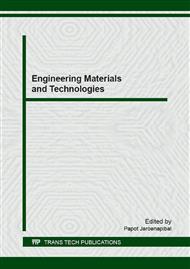p.51
p.57
p.62
p.67
p.72
p.77
p.81
p.87
p.95
Trace Lead Removal in Drinking Water Using High Capacity Polymeric Supported Hydrated Iron Oxide Nanoparticles
Abstract:
Ferric oxide nanoparticles are environmentally benign and can be selective toward lead, especially in neutral to mildly alkaline pH of groundwater. However, due to very fine particles and low mechanical strength, it prevents these materials to apply in point of use filter or large scale fixed-bed adsorption. In this study, polymeric gel cation exchanger, Purolite C100, supported ferric oxide nanoparticles, C100-Fe, was synthesized, characterized, and tested with challenging water according to NSF standards 53. From SEM-EDX studies, it can imply that high concentration of iron can be doped and distributed within the gel phase structure of the C100 approximately 22% by mass. The TEM micrographs confirm the size of hydrated ferric oxide fall into the nanometer range about 10-60 mm. The fixed-bed adsorption experiments demonstrated that C100-Fe can remove lead below the stringent standard of 0.05 mg/L up to 15,000 BVs, whereas the GAC, GAC-Fe, and C100 can treat the same test water only 1200, 1700, and 3500 BVs, respectively. The results confirm that C100-Fe can be efficiently substituted to the traditional GAC for lead removal in drinking water.
Info:
Periodical:
Pages:
72-76
Citation:
Online since:
November 2016
Keywords:
Price:
Сopyright:
© 2017 Trans Tech Publications Ltd. All Rights Reserved
Share:
Citation:


